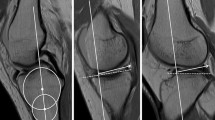Abstract
Purpose
The purpose of this study was to assess, in anterior cruciate ligament (ACL)-injured and -uninjured population, tibial plateau anatomic variables [medial and lateral tibial plateau slopes (MTPS and LTPS) and medial tibial plateau depth (MTPD)] on conventional magnetic resonance imaging (MRI) using a novel combined method and to determine whether these variables are risk factors for ACL injury.
Methods
Seventy-three isolated ACL-injury patients (20 women and 53 men) were compared with 51 control group patients (19 women and 32 men).
Results
The combined method had very high interrater and intrarater reliability compared with previously described methods. LTPS was significantly steeper in the overall injured group and injured men compared with the control group, with odds ratio (OR) of 3.031 and 5.89, respectively. Women with ACL injury had significantly shallower MTPD than uninjured women, with OR of 4.13.
Conclusions
We conclude that the new combined method is accurate and reproducible for assessing the tibial plateau anatomy. Women with shallower MTPD and men with steeper LTPS are at higher risk of sustaining ACL injury. Overall, steeper LTPS is a significant risk factor for sustaining ACL injury.


Similar content being viewed by others
References
Fink C, Hoser C, Hackl W, Navarro RA, Benedetto KP (2001) Long-term outcome of operative or nonoperative treatment of anterior cruciate ligament rupture–is sports activity a determining variable? Int J Sports Med 22(4):304–309
Griffin LY, Agel J, Albohm MJ et al (2000) Noncontact anterior cruciate ligament injuries: risk factors and prevention strategies. J Am Acad Orthop Surg 8:141–150
Pećina M, Bajok I, Pećina HI (2001) Tuberculum Intercondylare Tibiae Tertium as a Predictive Factor in the Anterior Cruciate Ligament Injury. Am J Sports Med 29(6):709–711
Renstrom P, Ljungqvist A, Arendt E et al (2008) Non-contact ACL injuries in female athletes: an International olympic committee current concepts statement. Br J Sports Med 42:394–412
Souryal TO, Moore HA, Evans JP (1988) Bilaterality in anterior cruciate ligament injuries: associated intercondylar notch stenosis. Am J Sports Med 16:449–454
Shelbourne KD, Facibene WA, Hunt JJ (1997) Radiographic and intraoperative intercondylar notch width measurements in men and women with unilateral and bilateral anterior cruciate ligament tears. Knee Surg Sports Traumatol Arthrosc 5:229–233
Shelbourne KD, Davis TJ, Klootwyk TE (1998) The relationship between intercondylar notch width of the femur and the incidence of anterior cruciate ligament tears A prospective study. Am J Sports Med 26:402–408
Domzalski M, Grzelak P, Gabos P (2010) Risk factors for Anterior Cruciate Ligament injury in skeletally immature patients: analysis of intercondylar notch width using Magnetic Resonance Imaging. Int Orthop 34(5):703–707
Dejour H, Bonnin M (1994) Tibial translation after anterior cruciate ligament rupture Two radiological tests compared. J Bone Joint Surg Br 76:745–749
Li G, Rudy TW, Allen C, Sakane M, Woo SL (1998) Effect of combined axial compressive and anterior tibial loads on in situ forces in the anterior cruciate ligament: A porcine study. J Orthop Res 16:122–127
Torzilli PA, Deng X, Warren RF (1994) The effect of joint-compressive load and quadriceps muscle force on knee motion in the intact and anterior cruciate ligament-sectioned knee. Am J Sports Med 22:105–112
Hashemi J, Chandrashekar N, Gill B et al (2008) The geometry of the tibial plateau and its influence on the biomechanics of the tibiofemoral joint. J Bone Joint Surg Am 90:2724–2734
Hashemi J, Chandrashekar N, Mansouri H, Gill B, Slauterbeck JR, Schutt RC Jr, Dabezies E, Beynnon BD (2010) Shallow medial tibial plateau and steep medial and lateral tibial slopes: new risk factors for anterior cruciate ligament injuries. Am J Sports Med 38(1):54–62
Meister K, Talley MC, Horodyski MB, Indelicato PA, Hartzel JS, Batts J (1998) Caudal slope of the tibia and its relationship to noncontact injuries to the ACL. Am J Knee Surg 11:217–219
Brandon ML, Haynes PT, Bonamo JR, Flynn MI, Barrett GR, Sherman MF (2006) The association between posterior-inferior tibial slope and anterior cruciate ligament insufficiency. Arthroscopy 22:894–899
Todd MS, Lalliss S, Garcia E, DeBerardino TM, Cameron KL (2010) The relationship between posterior tibial slope and anterior cruciate ligament injuries. Am J Sports Med 38(1):63–67
Stijak L, Herzog RF, Schai P (2008) Is there an influence of the tibial slope of the lateral condyle on the ACL lesion? A case-control study. Knee Surg Sports Traumatol Arthrosc 16(2):112–117
Bisson LJ, Gurske-DePerio J (2010) Axial and sagittal knee geometry as a risk factor for noncontact anterior cruciate ligament tear: a case-control study. Arthroscopy 26(7):901–906
Simon RA, Everhart JS, Nagaraja HN, Chaudhari AM (2010) A case-control study of anterior cruciate ligament volume, tibial plateau slopes and intercondylar notch dimensions in ACL-injured knees. J Biomech 43(9):1702–1707
Hudek R, Schmutz S, Regenfelder F, Fuchs B, Koch PP (2009) Novel measurement technique of the tibial slope on conventional MRI. Clin Orthop Relat Res 467(8):2066–2072
Matsuda S, Miura H, Nagamine R, Urabe K, Ikenoue T, Okazaki K, Iwamoto Y (1999) Posterior tibial slope in the normal and varus knee. Am J Knee Surg 12:165–168
Brazier J, Miguad H, Gougeon F, Cotten A, Fontaine C, Duquennoy A (1996) Evaluation of methods for radiographic measurement of the tibial slope. A study of 83 healthy knees. Rev Chir Orthop Reparatrice Appar Mot 82(3):195–200
Kessler MA, Burkart A, Martinek V, Beer A, Imhoff AB (2003) [Development of a 3-dimensional method to determine the tibial slope with multislice-CT] [in German]. Z Orthop Ihre Grenzgeb 141:143–147
Markolf KL, Burchfield DM, Shapiro MM, Shepard MF, Finerman GA, Slauterbeck JL (1995) Combined knee loading states that generate high anterior cruciate ligament forces. J Orthop Res 13(6):930–935
Yagi T, Sasaki T (1986) Tibial torsion in patients with medial-type osteoarthritic knee. Clin Orthop Relat Res 213:177–182
Conflict of interest statement
The authors declare that they have no conflict of interest. The authors did not receive any outside funding or grants in support of their research for or preparation of this work. Neither they nor a member of their immediate families received payments or other benefits or a commitment or agreement to provide such benefits from a commercial entity.
Author information
Authors and Affiliations
Corresponding author
Rights and permissions
About this article
Cite this article
Khan, M.S., Seon, J.K. & Song, E.K. Risk factors for anterior cruciate ligament injury: assessment of tibial plateau anatomic variables on conventional MRI using a new combined method. International Orthopaedics (SICOT) 35, 1251–1256 (2011). https://doi.org/10.1007/s00264-011-1217-7
Received:
Accepted:
Published:
Issue Date:
DOI: https://doi.org/10.1007/s00264-011-1217-7




